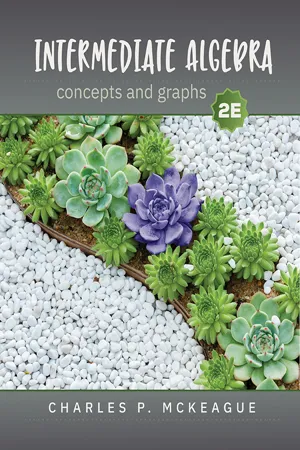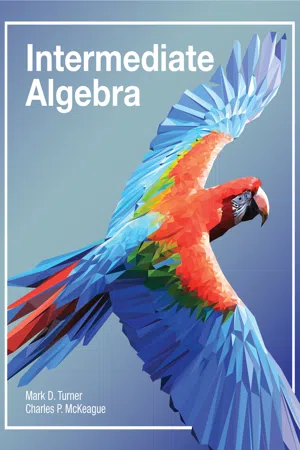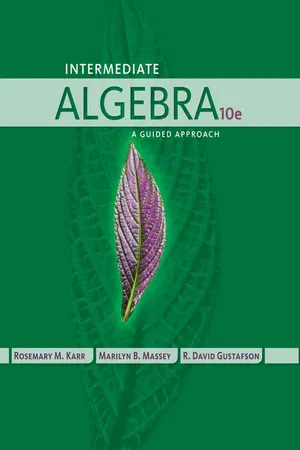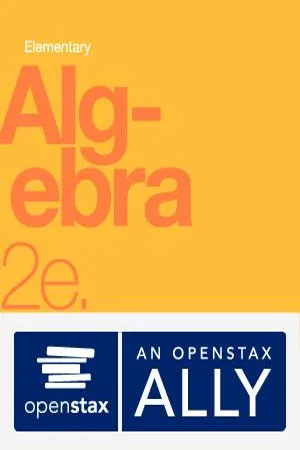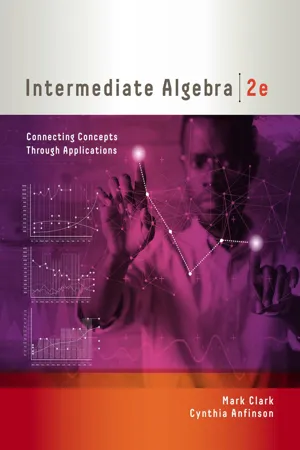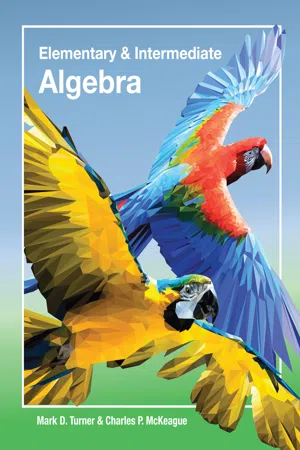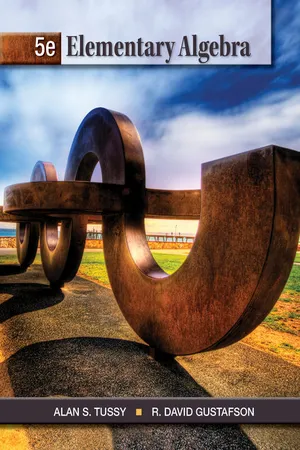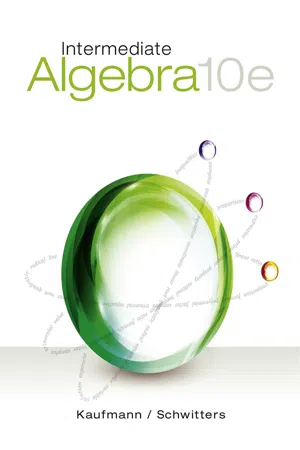Mathematics
Addition and Subtraction of Rational Expressions
The addition and subtraction of rational expressions involves combining or separating algebraic fractions. To add or subtract rational expressions, you need to find a common denominator, then perform the operation on the numerators while keeping the common denominator. Simplifying the resulting expression is often necessary to obtain the final answer.
Written by Perlego with AI-assistance
Related key terms
1 of 5
11 Key excerpts on "Addition and Subtraction of Rational Expressions"
- eBook - PDF
Intermediate Algebra
Concepts and Graphs 2E
- Charles P. McKeague(Author)
- 2019(Publication Date)
- XYZ Textbooks(Publisher)
5.3 Addition and Subtraction of Rational Expressions 435 EXAMPLE 9 Subtract 2 − 9 _____ 3x + 1 . SOLUTION To subtract these two expressions, we think of 2 as a rational expression with a denominator of 1. 2 − 9 _____ 3x + 1 = 2 __ 1 − 9 _____ 3x + 1 The LCD is 3x + 1. Multiplying the numerator and denominator of the first expression by 3x + 1 gives us a rational expression equivalent to 2, but with a denominator of 3x + 1. 2 __ 1 ⋅ (3x + 1) _______ (3x + 1) − 9 _____ 3x + 1 = 6x + 2 − 9 _________ 3x + 1 = 6x − 7 ______ 3x + 1 The numerator and denominator of this last expression do not have any factors in common other than 1, so the expression is in lowest terms. EXAMPLE 10 Write an expression for the sum of a number and twice its reciprocal. Then, simplify that expression. SOLUTION If x is the number, then its reciprocal is 1 _ x . Twice its reciprocal is 2 _ x . The sum of the number and twice its reciprocal is x + 2 __ x To combine these two expressions, we think of the first term x as a rational expression with a denominator of 1. The LCD is x: x + 2 __ x = x __ 1 + 2 __ x = x __ 1 ⋅ x _ x + 2 __ x = x 2 + 2 _____ x Getting Ready for CLASS After reading through the preceding section, respond in your own words and in complete sentences. A. Briefly describe how you would add two rational expressions that have the same denominator. B. Why is factoring important in finding a least common denominator? C. What is the last step in adding or subtracting two rational expressions? D. Explain how you would change the fraction 5 ____ x − 3 to an equivalent fraction with denominator x 2 − 9. Problem Set 5.3 436 Combine the following fractions. 1. 3 __ 4 + 1 __ 2 2. 5 __ 6 + 1 __ 3 3. 2 __ 5 − 1 __ 15 4. 5 __ 8 − 1 __ 4 5. 5 __ 6 + 7 __ 8 6. 3 __ 4 + 2 __ 3 7. 9 __ 48 − 3 __ 54 8. 6 __ 28 − 5 __ 42 9. 3 __ 4 − 1 __ 8 + 2 __ 3 10. 1 __ 3 − 5 __ 6 + 5 __ 12 Combine the following rational expressions. Reduce all answers to lowest terms. 11. x _____ x + 3 + 3 _____ x + 3 12. - eBook - PDF
- Mark D. Turner, Charles P. McKeague(Authors)
- 2016(Publication Date)
- XYZ Textbooks(Publisher)
In the following examples, we will not show all the steps we showed in Example 1. The steps are shown in Example 1 so you will see why both fractions must have the same denominator before we can add them. In practice, we simply add numerators and place the result over the common denominator. VIDEO EXAMPLES SECTION 6.3 EXAMPLE 1 434 CHAPTER 6 Rational Expressions and Rational Functions We add and subtract rational expressions with the same denominator by combining numerators and writing the result over the common denominator. Then we reduce the result to lowest terms, if possible. Example 2 shows this process in detail. If you see the similarities between operations on rational numbers and operations on rational expressions, this chapter will look like an extension of rational numbers rather than a completely new set of topics. Add: x _____ x 2 − 1 + 1 _____ x 2 − 1 . SOLUTION Because the denominators are the same, we simply add numerators: x _____ x 2 − 1 + 1 _____ x 2 − 1 = x + 1 _____ x 2 − 1 Add numerators = x + 1 ___________ ( x − 1)( x + 1) Factor denominator = 1 _____ x − 1 Divide out common factor x + 1 Our next example involves subtraction of rational expressions. Pay careful attention to what happens to the signs of the terms in the numerator of the second expression when we subtract it from the first expression. Subtract: 2 x − 5 ______ x − 2 − x − 3 _____ x − 2 . SOLUTION Because each expression has the same denominator, we simply subtract the numerator in the second expression from the numerator in the first expression and write the difference over the common denominator x − 2. We must be careful, however, that we subtract both terms in the second numerator. To ensure that we do, we will enclose that numerator in parentheses. - eBook - PDF
Intermediate Algebra
A Guided Approach
- Rosemary Karr, Marilyn Massey, R. Gustafson, , Rosemary Karr, Marilyn Massey, R. Gustafson(Authors)
- 2014(Publication Date)
- Cengage Learning EMEA(Publisher)
Add and subtract two rational expressions with unlike denominators. Perform operations on three or more rational expressions. 1 Adding and Subtracting Rational Expressions 4 Determine whether the fractions are equal. 1. 3 5 , 3 5 2. 3 7 , 18 40 3. 8 13 , 40 65 4. 7 25 , 42 150 5. 23 32 , 46 66 6. 8 9 , 64 72 Getting Ready 6.3 We now discuss how to add and subtract rational expressions. After mastering these skills, we will simplify expressions that involve more than one operation. Add and subtract two rational expressions with like denominators. Rational expressions with like denominators are added and subtracted according to the following procedures. 1 Unless otherwise noted, all content on this page is © Cengage Learning. Copyright 2013 Cengage Learning. All Rights Reserved. May not be copied, scanned, or duplicated, in whole or in part. Due to electronic rights, some third party content may be suppressed from the eBook and/or eChapter(s). Editorial review has deemed that any suppressed content does not materially affect the overall learning experience. Cengage Learning reserves the right to remove additional content at any time if subsequent rights restrictions require it. 386 CHAPTER 6 Rational Expressions ADDING AND SUBTRACTING RATIONAL EXPRESSIONS If no denominators are 0, then a b 1 c b 5 a 1 c b and a b 2 c b 5 a 2 c b In words, we add (or subtract) rational expressions with like denominators by adding (or subtracting) the numerators and keeping the common denominator. Whenever possible, we should simplify the result. Simplify; assume no denominators are 0. a. 17 22 1 13 22 b. 3 2 x 1 7 2 x c. 4 x x 1 2 2 7 x x 1 2 a. 17 22 1 13 22 5 17 1 13 22 b. 3 2 x 1 7 2 x 5 3 1 7 2 x 5 30 22 5 10 2 x 5 15 ? 2 11 ? 2 5 2 ? 5 2 ? x 5 15 11 5 5 x c. 4 x x 1 2 2 7 x x 1 2 5 4 x 2 7 x x 1 2 5 2 3 x x 1 2 Simplify; assume no denominators are 0. - eBook - PDF
- Lynn Marecek, MaryAnne Anthony-Smith, Andrea Honeycutt Mathis(Authors)
- 2020(Publication Date)
- Openstax(Publisher)
RATIONAL EXPRESSIONS AND EQUATIONS 8 Chapter 8 Rational Expressions and Equations 903 BE PREPARED : : 8.2 Factor: 6x 2 − 7x + 2. If you missed this problem, review Example 7.34. BE PREPARED : : 8.3 Factor: n 3 + 8. If you missed this problem, review Example 7.54. In Chapter 1, we reviewed the properties of fractions and their operations. We introduced rational numbers, which are just fractions where the numerators and denominators are integers, and the denominator is not zero. In this chapter, we will work with fractions whose numerators and denominators are polynomials. We call these rational expressions. Rational Expression A rational expression is an expression of the form p(x) q(x) , where p and q are polynomials and q ≠ 0. Remember, division by 0 is undefined. Here are some examples of rational expressions: − 13 42 7y 8z 5x + 2 x 2 − 7 4x 2 + 3x − 1 2x − 8 Notice that the first rational expression listed above, − 13 42 , is just a fraction. Since a constant is a polynomial with degree zero, the ratio of two constants is a rational expression, provided the denominator is not zero. We will perform same operations with rational expressions that we do with fractions. We will simplify, add, subtract, multiply, divide, and use them in applications. Determine the Values for Which a Rational Expression is Undefined When we work with a numerical fraction, it is easy to avoid dividing by zero, because we can see the number in the denominator. In order to avoid dividing by zero in a rational expression, we must not allow values of the variable that will make the denominator be zero. If the denominator is zero, the rational expression is undefined. The numerator of a rational expression may be 0—but not the denominator. So before we begin any operation with a rational expression, we examine it first to find the values that would make the denominator zero. - eBook - PDF
Intermediate Algebra
Connecting Concepts through Applications
- Mark Clark, Cynthia Anfinson(Authors)
- 2018(Publication Date)
- Cengage Learning EMEA(Publisher)
Simplify complex fractions. 7.4 Now that we have studied simplifying, multiplying, and dividing rational expressions, we are going to learn how to add and subtract them. Adding and subtracting fractions requires common denominators. This is different than multiplying and dividing rational expressions, where we do not need common denominators. Being able to add and subtract rational expressions allows us to simplify problems where several rational expressions are used. Least Common Denominator Finding a common denominator for a rational expression is similar to the process for numeric fractions. When finding the least common denominator (LCD) of a fraction, we first factor each denominator and compare factors to select the right combination that makes up the LCD. In some cases, we can figure out the LCD without doing all of these steps, but with rational expressions, it takes patience. Steps to Write Fractions in Terms of the LCD 1. Find the least common denominator. 2. Determine what factors of the LCD the fraction’s denominator is missing. 3. Multiply the numerator and denominator of the fraction by the missing factors. Note: We generally leave polynomial denominators factored but multiply out monomial factors. Skill Connection Finding a common denominator When adding or subtracting fractions, we need a common denominator. If the fractions do not have a common denominator, first find the LCD. Then rewrite the fractions in terms of the LCD. Example: Find the LCD for the given fractions and rewrite each fraction in terms of the LCD. 12 35 8 495 Solution 12 35 8 495 Factor both denominators. 12 5 # 7 8 3 2 # 5 # 11 Include the highest power of each factor for the LCD. LCD 5 3 2 # 5 # 7 # 11 LCD 5 3465 Multiply each fraction by the factors that its denominator is missing. - eBook - PDF
Introductory Algebra
Concepts with Applications
- Charles P. McKeague(Author)
- 2013(Publication Date)
- XYZ Textbooks(Publisher)
= (x − 6)(x + 5) ____________ 2(x + 5)(x − 5) = x − 6 _______ 2(x − 5) Answers 7. 6x + 11 _____________ (x − 4)(x − 3)(x + 3) 8. x − 5 _____ 2(x − 4) 7. Add 5 __________ x 2 − 7x + 12 + 1 _____ x 2 − 9 . 8. Subtract x + 3 _____ 2x + 8 − 4 ______ x 2 − 16 . Note In the last step, we reduced the rational expression to lowest terms by dividing out the common factor of x + 5. 475 6.3 Addition and Subtraction of Rational Expressions EXAMPLE 9 Write an expression for the sum of a number and its reciprocal, and then simplify that expression. Solution If we let x = the number, then its reciprocal is 1 _ x . To find the sum of the number and its reciprocal, we add them. x + 1 __ x The first term x can be thought of as having a denominator of 1. Since the denominators are 1 and x, the least common denominator is x. x + 1 __ x = x __ 1 + 1 __ x Write x as x _ 1 . = x __ 1 ⋅ x _ x + 1 __ x The LCD is x. = x 2 __ x + 1 __ x = x 2 + 1 _____ x Add numerators. Answer 9. 2x 2 − 1 _____ x 9. Write an expression for the difference of twice a number and its reciprocal. Then simplify. GETTING READY FOR CLASS After reading through the preceding section, respond in your own words and in complete sentences. A. How do you add two rational expressions that have the same denominator? B. What is the least common denominator for two fractions that include rational expressions? C. What role does factoring play in finding a least common denominator when adding rational expressions? D. Explain how, if possible, you would reduce the solution to an addition problem of two rational expressions. EXERCISE SET 6.3 476 Chapter 6 Rational Expressions and Equations SCAN TO ACCESS Vocabulary Review Choose the correct words to fill in the blanks below. different reduce same least common denominator 1. To add or subtract rational expressions with the denominator, combine numerators and put the result over the common denominator. - eBook - PDF
- Mark D. Turner, Charles P. McKeague(Authors)
- 2016(Publication Date)
- XYZ Textbooks(Publisher)
Once we have done that, we simply add numerators. The same process can be used to add rational expressions, as the next example illustrates. Subtract: 3 __ x − 1 __ 2 . SOLUTION Step 1: The LCD for x and 2 is 2 x . It is the smallest expression divisible by x and by 2. Step 2: To change to equivalent expressions with the denominator 2 x , we multiply the first fraction by 2 _ 2 and the second by x _ x : 3 __ x ⋅ 2 __ 2 = 6 __ 2 x 1 __ 2 ⋅ x _ x = x __ 2 x EXAMPLE 6 Note If you have had difficulty in the past with addition and subtraction of fractions with different denominators, this is the time to get it straightened out. Go over Example 6 as many times as is necessary for you to understand the process. EXAMPLE 7 472 Chapter 7 Rational Expressions Step 3: Subtracting numerators of the rational expressions in step 2, we have 6 __ 2 x − x __ 2 x = 6 − x _____ 2 x Step 4: Since 6 − x and 2 x do not have any factors in common, we cannot reduce any further. Here is the complete problem: 3 __ x − 1 __ 2 = 3 __ x ⋅ 2 __ 2 − 1 __ 2 ⋅ x _ x = 6 __ 2 x − x __ 2 x = 6 − x _____ 2 x Add: 5 _____ 2 x − 6 + x _____ x − 3 . SOLUTION If we factor 2 x − 6, we have 2 x − 6 = 2( x − 3). The LCD is 2( x − 3). We need only multiply the second rational expression in our problem by 2 _ 2 to have two expressions with the same denominator: 5 _____ 2 x − 6 + x _____ x − 3 = 5 _______ 2( x − 3) + x _____ x − 3 = 5 _______ 2( x − 3) + 2 __ 2 x _____ x − 3 = 5 _______ 2( x − 3) + 2 x _______ 2( x − 3) = 2 x + 5 _______ 2( x − 3) Add: 1 _____ x + 4 + 8 ______ x 2 − 16 . SOLUTION After writing each denominator in factored form, we find that the least common denominator is ( x + 4)( x − 4). - eBook - PDF
- Alan Tussy, R. Gustafson(Authors)
- 2012(Publication Date)
- Cengage Learning EMEA(Publisher)
1. A quotient of two polynomials, such as , is called a expression. 2. To simplify a rational expression, we remove common of the numerator and denominator. 3. Because of the division by 0, the expression is . 4. The binomials and are called , because their terms are the same, except that they are opposite in sign. 15 x x 15 8 0 x 2 x x 2 3 x CONCEPTS 5. When we simplify , the result is . These equivalent expressions have the same value for all real numbers, except . Show that they have the same value for . 6. Determine whether each pair of polynomials are opposites. Write yes or no. a. and b. and c. and x 2 2 x 1 x 2 2 x 1 20 b b 20 y 7 y 7 x 1 x 5 x 4 x 2 5 x 4 x 20 Copyright 201 Cengage Learning. All Rights Reserved. May not be copied, scanned, or duplicated, in whole or in part. Due to electronic rights, some third party content may be suppressed from the eBook and/or eChapter(s). Editorial review has deemed that any suppressed content does not materially affect the overall learning experience. Cengage Learning reserves the right to remove additional content at any time if subsequent rights restrictions require it. Find all real numbers for which the rational expression is undefined. See Example 2. 23. 24. 25. 26. 27. 28. 29. 30. 31. 32. 33. 34. 35. 36. 37. 38. Simplify. See Example 3. 39. 40. 41. 42. Simplify. See Example 4. 43. 44. 45. 46. 47. 48. 49. 50. Simplify. See Example 5. 51. 52. 53. 54. Simplify. See Example 6. 55. 56. 57. 58. Simplify. - eBook - PDF
- Jerome Kaufmann, Karen Schwitters, , , Jerome Kaufmann, Karen Schwitters(Authors)
- 2014(Publication Date)
- Cengage Learning EMEA(Publisher)
Cengage Learning reserves the right to remove additional content at any time if subsequent rights restrictions require it. Chapter 4 • Rational Expressions 202 (a) 1 x 2 1 2 x x 2 1 (b) 3 2 x 2 3 2 2 x 2 x 2 3 (c) 4 x 2 4 2 x x 2 4 1 1 (d) 2 1 1 2 x 2 2 2 x x 2 2 68. Consider the addition problem 8 x 2 2 1 5 2 2 x . Note that the denominators are opposites of each other. If the property a 2 b 5 2 a b is applied to the second fraction, we have 5 2 2 x 5 2 5 x 2 2 . Thus we proceed as follows: 8 x 2 2 1 5 2 2 x 5 8 x 2 2 2 5 x 2 2 5 8 2 5 x 2 2 5 3 x 2 2 Use this approach to do the following problems. (a) 7 x 2 1 1 2 1 2 x (b) 5 2 x 2 1 1 8 1 2 2 x (c) 4 a 2 3 2 1 3 2 a (d) 10 a 2 9 2 5 9 2 a (e) x 2 x 2 1 2 2 x 2 3 1 2 x (f) x 2 x 2 4 2 3 x 2 28 4 2 x 69. What is the difference between the concept of least common multiple and the concept of least common denominator? 70. A classmate tells you that she finds the least common multiple of two counting numbers by listing the multi-ples of each number and then choosing the smallest number that appears in both lists. Is this a correct pro-cedure? What is the weakness of this procedure? 71. For which real numbers does x x 2 3 1 4 x equal ( x 1 6)( x 2 2) x ( x 2 3) ? Explain your answer. 72. Suppose that your friend does an addition problem as follows: 5 8 1 7 12 5 5(12) 1 8(7) 8(12) 5 60 1 56 96 5 116 96 5 29 24 Is this answer correct? If not, what advice would you offer your friend? Answers to the Concept Quiz 1. False 2. True 3. True 4. True 5. True 6. True 7. False 8. False 9. True 10. True O B J E C T I V E S Add and subtract rational expressions Simplify complex fractions 1 2 4.4 More on Rational Expressions and Complex Fractions In this section, we expand our work with adding and subtracting rational expressions, and we discuss the process of simplifying complex fractions. Before we begin, however, this seems like an appropriate time to offer a bit of advice regarding your study of algebra. - eBook - PDF
Beginning Algebra
Connecting Concepts through Applications
- Mark Clark, Cynthia Anfinson(Authors)
- 2018(Publication Date)
- Cengage Learning EMEA(Publisher)
4. Factor the numerator and reduce (if possible). Note: When subtracting rational expressions, be sure to use the distributive property to distribute the minus sign to the entire numerator of the second fraction. Skill Connection Adding and subtracting numerical fractions with different denominators Find the LCD and rewrite each fraction with the LCD. Next add or subtract the numerators, and keep the same denominator. Reduce the fraction if possible. To add 2 5 1 4 3 , find the LCD, which is 5 # 3 5 15 . Rewriting each fraction with a denominator of 15 and adding, we get 2 5 1 4 3 5 2 5 # 3 3 1 4 3 # 5 5 5 6 15 1 20 15 5 26 15 Copyright 2019 Cengage Learning. All Rights Reserved. May not be copied, scanned, or duplicated, in whole or in part. Due to electronic rights, some third party content may be suppressed from the eBook and/or eChapter(s). Editorial review has deemed that any suppressed content does not materially affect the overall learning experience. Cengage Learning reserves the right to remove additional content at any time if subsequent rights restrictions require it. C H A P T E R 7 R a t i o n a l E x p r e s s i o n s a n d E q u a t i o n s 620 Example 7 Adding and subtracting rational expressions with unlike denominators Add or subtract the following rational expressions. Reduce the final answer. a. 3 xy 1 2 5 y 2 b. 2 x x 1 4 1 5 x 2 3 c. 3 h 1 4 h 1 2 2 7 d. 5 1 n 1 1 21 n 2 2 2 1 n 1 3 1 n 1 4 21 n 2 2 2 SOLUTION x +1 x +1 a. Step 1 Find the LCD. 3 xy 1 2 5 y 2 5 3 xy 1 2 5 y 2 The LCD is 5 xy 2 . Step 2 Rewrite all fractions with the LCD. 5 5 y 5 y # 3 xy 1 2 5 y 2 # x x 5 15 y 5 xy 2 1 2 x 5 xy 2 Multiply out the numerators. Step 3 Add or subtract the numerators. Write the sum or difference with the common denominator. 5 15 y 1 2 x 5 xy 2 Step 4 Factor the numerator and reduce (if possible). 5 2 x 1 15 y 5 xy 2 These are not like terms. This is simplified. - eBook - ePub
A Focus on Fractions
Bringing Mathematics Education Research to the Classroom
- Marjorie M. Petit, Robert E. Laird, Caroline B. Ebby, Edwin L. Marsden(Authors)
- 2022(Publication Date)
- Routledge(Publisher)
An important instructional point is exemplified by Cody’s, Oscar’s, and Lisa’s responses: “Students need facility with a variety of computational tools, and they need to know how to select the appropriate tool for a given situation” (NRC, 2001, p. 122). Although each response includes a different strategy to answer the questions correctly, Lisa’s strategy of reasoning about the quantities involved may be the most efficient, given a context that does not require an exact numerical answer. Oscar’s solution using a physical visual model might illustrate a developing understanding of estimating fraction sums. The evidence in Cody’s response suggests that he is developing fluency with an algorithm when adding and subtracting fractions. Although this may not be the most efficient strategy for this problem, it may be quite efficient for a problem that requires an exact sum.Unit Fractions and Fraction Addition and Subtraction
As discussed in Chapter 1, unit fractions are the building blocks for developing understanding of fraction addition and subtraction. Students begin building the understanding that fractions are composed of unit fractions when they use number lines and area models to add fractions with common denominators. Sam’s solution in Figure 11.11 provides evidence that he understands fractions are built from unit fractions and that the sum of fractions with like denominators is the sum of the associated unit fractions.Sam used a number line and unit fractions to determine thatFigure11.10and that2 8+1 8=3 83 8is closest to 0.This essential notion that fractions are composed of unit fractions can help students transition from reliance on number lines and other visual models to solve problems involving addition and subtraction of fractions with common denominators ().3 4+2 4=1 4+1 4+1 4+1 4+1 4=5 4Ethan’s response in Figure 11.12 suggests an understanding that. He uses this to subtract3 5=1 5+1 5+1 53 5from2.1 5Ethan’s response. Ethan used his understanding that fractions can be decomposed into unit fractions to subtractFigure11.123 5from2.1 5Alyssa’s response in Figure 11.13 shows evidence that she used unit fraction understanding to decompose3 5into. When students solve problems involving addition and subtraction of fractions with unlike denominators, they combine their understanding of addition and subtraction of fractions (developed using unit fraction understanding) with their understanding of equivalence by finding common denominators before adding or subtracting the fractions. Kenny’s response in Figure 11.1 illustrates the use of common denominators when adding fractions as well as evidence of unit fraction understanding when he indicates that1 5+2 512 12= 1
Index pages curate the most relevant extracts from our library of academic textbooks. They’ve been created using an in-house natural language model (NLM), each adding context and meaning to key research topics.
